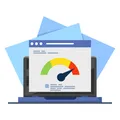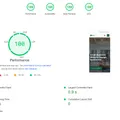What Kind of Website Does My Software Company Need?
If you run a Software as a Service (SaaS) company, your website is more than just somewhere for people to land, it’s a 24/7 salesperson which can be used to improve your credibility and can be a lead generation machine if done correctly. But with so many website options out there, how do you know what’s right for your business? Should you go for a single landing page, a basic template, or a fully custom-built site?
In this post, we’ll break down exactly what your software company needs in a website to attract leads, convert visitors, and scale with your business.
Why a Single Landing Page Website Won’t Cut It
A one-page website might seem like a quick and easy solution, but it comes with major limitations, especially for software companies trying to establish trust and attract clients. Here’s why:
1. Poor SEO Performance
Search engines thrive on structured websites with multiple pages containing organised content. A single landing page limits your ability to rank for multiple relevant keywords, reducing your chances of attracting organic traffic. If you’re serious about inbound marketing and lead generation, a single page won’t do the job.
2. Limited Scalability
Your software company is (hopefully) going to grow, and your website should grow with it. A single page site makes it difficult to add new features, product pages, case studies, or content marketing resources without cluttering the page and confusing visitors.
3. Lower Conversion Rates
Different visitors have different needs. Some might be looking for technical specifications, while others want to read case studies or book a demo. When you cram everything into one page, you risk overwhelming or losing prospects who don’t immediately find what they’re looking for. Adding multiple pages gives you more opportunities to share information, build trust and then convert.
4. Reduced Credibility
If a potential client lands on a single-page website, they may question your legitimacy. Larger software providers and clients expect a well-structured, professional website that reflects the sophistication of your product. When a prospect sees a one page website they don't think you're genuine, they think you're just another nobody whose created a meaningless SaaS product that no one cares about. Positioning yourself correctly is everything.
5. Slow Performance & Poor User Experience
With everything loaded on one page, performance suffers, especially on mobile devices which makes up 54% of website traffic. Speed is critical for user experience and SEO, and a single-page site often struggles to maintain fast load times, with many built on page-builder tools like Framer or Wix, which often lack mobile responsiveness and slow down performance, making your brand look unprofessional..
The Ideal Website Structure for a Software Company
If you want a website that actually drives leads and sales, here’s what your software company should include:
1. Homepage with a Clear Value Proposition
Your homepage should immediately communicate what your software does and how it solves a problem. Keep it clear, concise, and results-driven. Summarise everything which is covered on your website in 5-8 sections.
2. Product or Service Pages
Each product or service should have its own dedicated page, that has copy filled with keywords that uses the correct heading tags that can be used by search engines. This helps potential buyers find exactly what they need and improves your ranking on search engines.
3. Case Studies & Testimonials
Potential customers want proof that your software delivers results. A dedicated case study section featuring real-world success stories builds trust and credibility. Include numbers, success stories and insights into how your solutions solved your clients problems.
4. Pricing Page
Many software companies hesitate to include pricing, but transparent pricing is something we stand by, and is something that reduces friction in the buying process. You don't want your time wasted by individuals who can't afford your prices, and including the price can often lead to faster conversions as your client knows what they are signing up for.
5. Blog & Resources Section
A blog or resource hub is essential for driving organic traffic and establishing thought leadership. Cover industry trends, software best practices, and common pain points your clients face, much like what we're doing in this blog.
6. Contact or Book a Demo Pages
Make it easy for visitors to take the next step, include a contact form and calendar form within your website and limit the amount of clicks required to convert. A contact or book a demo page ensures leads don’t drop off without engaging with your team.
7. Fast, Secure, and Optimised Performance
Your site should load in under two seconds, be fully mobile-responsive, and meet security best practices to build trust and keep users engaged. We would always recommend a static website, limited scripts, no third-party plugins, with a bespoke design and custom-coded development so we optimise for your target market and for performance.
Want some help with finding the best path for your business? Book a call with our team.







